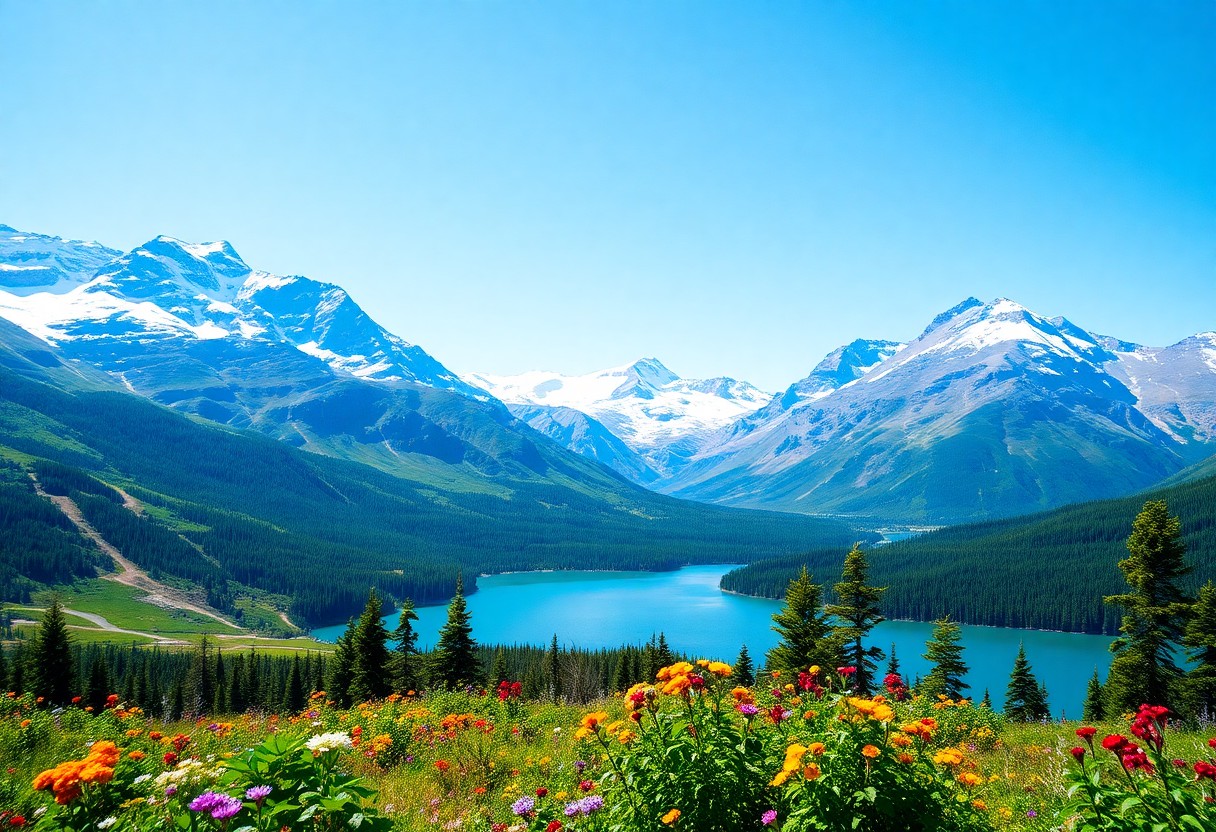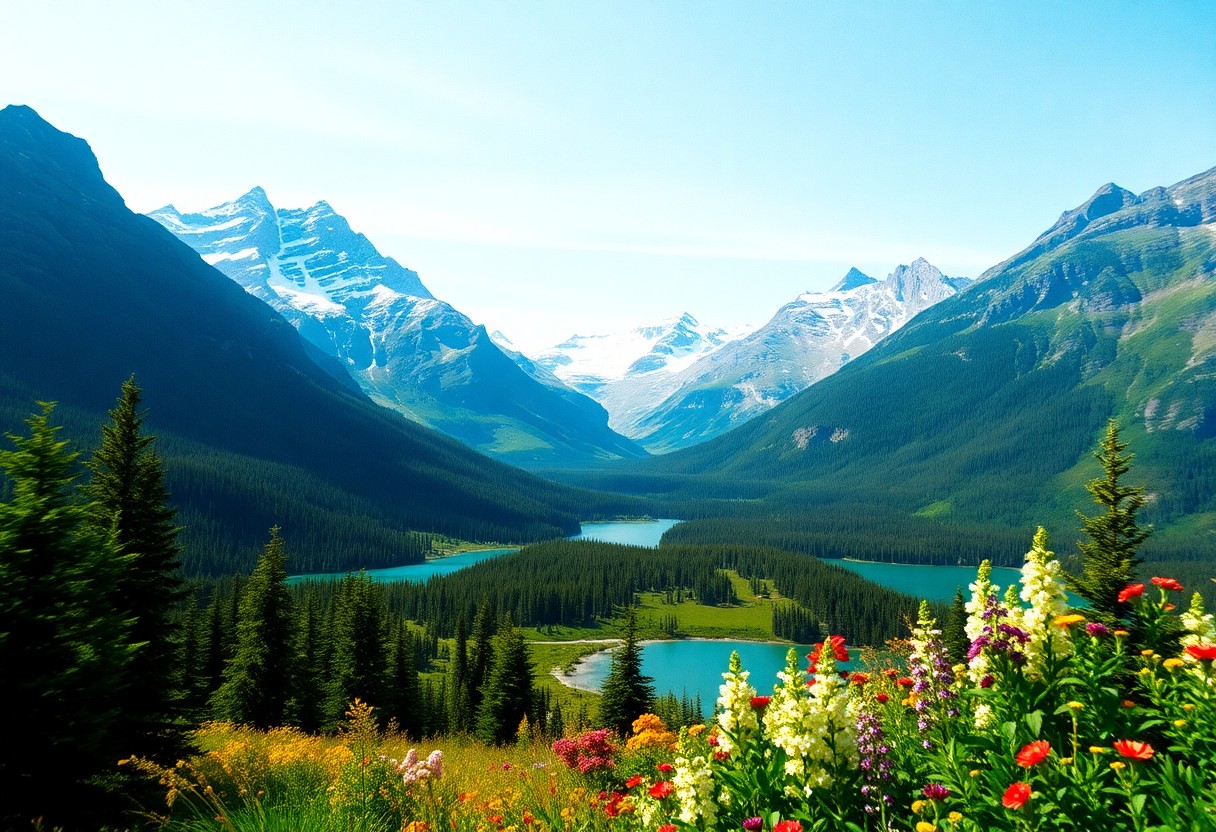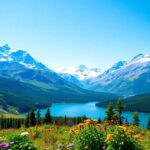
Just imagine yourself surrounded by towering peaks, crystal-clear lakes, and vibrant wildflowers as you explore Glacier National Park in Montana. This iconic destination offers you unparalleled opportunities to capture stunning photographs that showcase the raw beauty of nature. Whether you’re a seasoned photographer or simply enjoy snapping pictures on your travels, Glacier National Park provides a breathtaking backdrop that will elevate your visual storytelling to new heights.
Key Takeaways:
- Glacier National Park in Montana offers some of the most stunning natural landscapes in the United States, making it a top destination for nature photography.
- The park features diverse terrain including rugged mountains, pristine lakes, and ancient glaciers, providing a variety of scenic photo opportunities.
- Popular spots within the park for breathtaking photos include Going-to-the-Sun Road, Lake McDonald, and Hidden Lake Overlook.
- Wildlife such as bears, mountain goats, and moose add dynamic and captivating elements to photos taken in the park.
- Visiting during different seasons offers unique photographic experiences, from vibrant wildflowers and lush greenery in summer to snow-covered peaks in winter.
Iconic Landscapes Worth a Thousand Words
Every bend and vista in Glacier National Park offers a unique photo opportunity that tells its own story. The rugged diversity—from alpine ridges to glacial lakes—creates dramatic contrasts that enhance your compositions. Whether you’re aiming for sweeping panoramas or intimate nature shots, these iconic landscapes demand a deliberate eye for light and shadow, paving the way for images that resonate deeply and linger in memory.
The Allure of Going-to-the-Sun Road
Winding along 50 miles of breathtaking terrain, the Going-to-the-Sun Road is more than just a drive—it’s a visual feast. As you traverse this engineering marvel, every turn reveals cliffs soaring above, valleys carved by ancient glaciers, and wildlife crossing your path. Capturing the dynamic interplay of sunlight against jagged peaks yields images rich with texture and scale, compelling you to pause often and savor each frame.
Capturing Serenity at Lake McDonald
Lake McDonald’s glassy surface reflects the surrounding forest and mountains with striking clarity, offering tranquil compositions that emphasize stillness and natural harmony. Early morning mist and the subtle color shifts at sunset transform the scene into a painter’s palette. Your photos here can effortlessly evoke peace, inviting viewers to step into a calm, untouched wilderness moment frozen in time.
To enhance your shots, focus on the lake’s shoreline where smooth pebbles and fallen logs add foreground interest and depth. Midday often brings vibrant turquoise hues, while dusk bathes the scene in warm golds—perfect for experimenting with exposure settings. Don’t miss the chance to capture local wildlife like loons and herons that frequent this serene habitat, adding life and movement to your compositions.
Hidden Lake: A Secret Gem for Photographers
Hidden Lake’s remote location rewards those willing to hike its trail with spectacular alpine views framed by jagged peaks and wildflower meadows. The lake’s crystal-clear waters mirror the sky and rugged landscape, creating compositions that balance raw wilderness with mirrored stillness. This spot offers a quieter, less-traveled alternative to busier viewpoints, perfect for intimate nature photography.
The 2.7-mile hike to Hidden Lake Overlook gradually reveals varying perspectives, from dense forests to sweeping vistas, allowing you to capture diverse scenes within a compact area. The best light occurs during early morning or late afternoon when shadows add dimensionality. Wildlife sightings—especially mountain goats and marmots—often punctuate your imagery, enhancing the story behind each captivating photo.
Nature’s Canvas: Seasonal Splendors
Each season at Glacier National Park unveils a unique layer of its natural beauty. From vibrant bursts of wildflowers painting the meadows in summer to the serene, snow-draped landscapes of winter, the park offers endless opportunities to capture nature’s evolving palette. You’ll find yourself drawn to the intricate contrasts and colors that shift dramatically, providing fresh perspectives throughout the year. Whether your camera lens is focused on summer’s lively tapestries or winter’s quiet elegance, the park’s ever-changing scenery transforms your photographic journey.
The Burst of Color: Summer Wildflowers
Summer fuels a spectacular floral explosion across Glacier’s valleys and alpine meadows. Nearly 1,100 species of wildflowers bloom, including vibrant Indian paintbrush, beargrass, and glacier lilies, each contributing splashes of red, white, yellow, and purple against emerald backdrops. You can spot these blossoms from late June through July, often thriving alongside sparkling streams or amid rugged mountain slopes. Capturing these lively fields gives your photos a vibrant sense of life and place, inviting a closer look at the park’s delicate yet resilient botanical diversity.
Winter’s Embrace: Snow-Covered Beauty
Once winter settles, Glacier transforms into a magical snowscape, blanketing the terrain with several feet of snow that softens the rugged contours. You’ll witness an ethereal stillness as snow piles on ancient pines and frozen lakes, creating pristine scenes rarely accessible during warmer months. Winter’s hush gives photographers a chance to capture the park’s peaceful, untouched essence, where frost-laden branches and icy formations frame bold mountain silhouettes under pale winter skies.
Delving deeper into Glacier’s winter landscape reveals more than just glowing snowfields. Trails become silent corridors winding through snow-blanketed forests, where tracks of elk, moose, and snowshoe hares add storytelling elements to your shots. The low-angle winter sunlight casts long shadows and brings out textured details in snowdrifts and ice crystals, lending your images a crisp, tactile quality. Plus, the park’s colder temperatures mean clearer air, enhancing visibility of the jagged peaks and creating vibrant contrasts between the bright snow and deep blue skies, perfect for wintertime photography.
The Wild Side: Wildlife Encounters and Outdoor Adventures
You can witness majestic grizzly bears fishing in crystal-clear streams or spot mountain goats navigating sheer cliff faces with effortless grace. Glacier National Park is a living canvas of wildlife and exhilarating outdoor activities, from kayaking pristine lakes to scaling rugged peaks. The diversity and accessibility of the park’s wilderness invite you to capture nature’s raw beauty while engaging in thrilling adventures that test your limits and deepen your connection to the untamed landscapes.
Best Practices for Wildlife Photography
Observe from a respectful distance using a telephoto lens to maintain your safety and the animals’ comfort. Early mornings or late evenings provide the best natural light and active wildlife behavior. Mix patience with silence, as sudden movements can scare away elusive subjects. Using a tripod can keep your shots sharp, while knowing animal habits lets you anticipate captivating moments, turning your photography into an immersive storytelling experience.
Hiking Trails That Offer Unparalleled Views
Trails like the Highline Trail and Grinnell Glacier Trail lead you through stunning vistas, featuring panoramic mountain ranges and vibrant wildflower meadows. These pathways navigate diverse terrain that rewards every step with breathtaking views and intimate encounters with the park’s unique flora and fauna. Each trail is an invitation to explore further and capture images that convey the grandeur and serenity of Glacier’s rugged wilderness.
The Highline Trail stretches over 11.8 miles along the Continental Divide, offering cliff-hugging paths with awe-inspiring overlooks of glacial valleys below. On the other hand, the 7.6-mile Grinnell Glacier Trail paints a vivid picture of retreating ice fields, mountain tarns, and cascading waterfalls. Combining these hikes with strategically timed rest stops optimizes your chances of observing wildlife such as bighorn sheep and marmots, while providing countless photo opportunities framed by dramatic landscapes.
Mastering the Art of Photography in Glacier
Photography in Glacier National Park challenges you to adapt techniques tailored to its diverse landscapes. Experiment with framing against the park’s rugged peaks and vast skies to harness natural depth. Play with different focal lengths—from wide-angle lenses that capture dramatic panoramas to telephoto lenses that bring distant wildlife boldly into focus. Patience rewards in spotting golden hour moments, as light shifts quickly among jagged ridges and pristine lakes. Balancing exposure across high-contrast scenes ensures details remain vivid, especially during sunrise or sunset. Skilled use of manual settings can transform your captures into true reflections of Glacier’s wild majesty.
Techniques for Capturing Reflections on Water
Reflections on Glacier’s glassy lakes offer breathtaking symmetry, inviting you to compose shots that mirror jagged mountains and dense evergreens. Use a polarizing filter sparingly to manage glare without eliminating the enchanting water mirror effect. Lower your vantage point close to the water’s surface to enhance foreground interest and intensify reflection strength. Early mornings often provide the calmest waters, perfectly still for reflection shots. Deliberate framing that includes shoreline elements balances reflection with reality, creating compelling compositions that highlight the park’s serene beauty.
Harnessing the Magic of Mountain Light
Mountain light in Glacier National Park shifts dramatically throughout the day, casting long shadows and illuminating peaks with radiant, golden hues. Shooting during the early morning or late afternoon reveals rich contrasts and saturated colors, perfect for emphasizing textures and contours. Keep an eye on the interplay of light and shadow to capture dynamic landscapes that appear almost three-dimensional. Overcast days soften the light, allowing subtle details to emerge without harsh contrasts, offering a different but equally enchanting photographic atmosphere.
The park’s high elevations amplify light’s intensity, causing colors to pop vividly against the backdrop of alpine meadows and craggy cliffs. As the sun climbs, the varying angles reveal intricate patterns in the terrain—weathered rock faces, glacial remnants, and rushing streams. Planning your shoots around these changing conditions can lead to remarkable images that evoke Glacier’s distinct character. Using reflectors or graduated neutral density filters can help balance exposure between glowing skies and shadowed valley floors, ensuring the mountain light enhances rather than overwhelms your composition.
Navigating Your Visit: Travel Tips and Lodging Options
Maximize your Glacier experience by planning your visit during shoulder seasons to avoid crowds and snag better lodging deals. Prioritize early reservations, especially for Going-to-the-Sun Road shuttle services and campgrounds. Prepare for fluctuating weather by packing layers and waterproof gear. Consider these travel tips:
- Book accommodations months in advance, particularly for summer months
- Utilize park shuttle systems to reduce traffic impact and parking hassles
- Start hikes early to capture golden hour light and beat the crowds
- Keep park maps accessible offline due to limited cell reception
This approach ensures smoother logistics and enhances your ability to focus on capturing stunning photographs.
Routes and Modes of Exploration
Exploring Glacier National Park offers several distinct modes suited to your adventure style. Driving the iconic Going-to-the-Sun Road reveals panoramic vistas, but consider hiking the Highline Trail for dramatic ridgeline shots accessible by shuttle. For a more intimate experience, book a guided boat tour on Lake McDonald or venture on horseback along lesser-known paths. Cycling options also abound, allowing you to cover terrain quietly and efficiently while spotting wildlife. These varied travel routes provide numerous vantage points to capture the park’s beauty from unique perspectives.
Accommodations That Connect You to Nature
Staying within Glacier allows you to immerse fully in its wild ambiance. Historic lodges like the Many Glacier Hotel offer classic rustic charm alongside stunning lake or mountain views. For a more secluded retreat, opt for backcountry cabins or tent cabins nestled deep in the forest, accessible via hikes or shuttle services. Campgrounds such as Apgar and Fish Creek provide a traditional outdoor experience with imperative amenities. This variety in lodging options meets all comfort levels while keeping you close to the park’s natural splendor.
Many Glacier Hotel, built in 1915, stands out not only for its historic architecture but also for its proximity to hiking trails like Swiftcurrent Pass and Grinnell Glacier. Opt for a lakeside room to wake up to reflective waters and the calls of loons. For travelers seeking privacy, Granite Park Chalet offers a backcountry stay reachable by a moderate hike, where you can disconnect from digital distractions and enjoy star-filled skies. Whether you prefer historic luxury or rugged seclusion, Glacier’s accommodations deepen your engagement with the landscape and wildlife.
Final Words
Upon reflecting on Glacier National Park, Montana, you realize its unparalleled beauty makes it America’s most breathtaking natural photo backdrop. Whether you’re capturing soaring peaks, pristine lakes, or diverse wildlife, the park invites you to explore and preserve its stunning landscapes. Your adventure here not only offers incredible photo opportunities but also a deep connection with nature’s raw splendor, inspiring you to share and protect this precious environment for generations to come.
FAQ
Q: What makes Glacier National Park in Montana an ideal destination for nature photography?
A: Glacier National Park offers stunning and diverse landscapes, including rugged mountains, pristine lakes, alpine meadows, and dense forests. Its dramatic scenery, combined with varying light conditions throughout the day, provides photographers with endless opportunities to capture breathtaking images. The park’s iconic locations such as Going-to-the-Sun Road, Lake McDonald, and Grinnell Glacier are particularly popular for their panoramic and unique photographic appeal.
Q: When is the best time of year to visit Glacier National Park for photography?
A: The best time for photography in Glacier National Park largely depends on what you want to capture. Late spring through early fall (June to September) offers accessible trails, vibrant wildflowers, and clear skies. Early fall brings spectacular fall colors with changing foliage, while winter provides snowy landscapes ideal for dramatic shots if you are prepared for colder conditions. Sunrise and sunset times during these seasons often produce the most striking light conditions for photography.
Q: Are there any recommended spots within Glacier National Park that are particularly photogenic?
A: Yes, several spots are highly recommended for photography enthusiasts. Some of the most photogenic locations include Lake McDonald for its reflective waters, Many Glacier Valley for wildlife and mountainous backgrounds, Avalanche Lake for its cascading waterfalls, and Logan Pass for panoramic mountain views. Additionally, photographing from the Going-to-the-Sun Road affords various vantage points of valleys, peaks, and glaciers.
Q: What wildlife might photographers expect to encounter in Glacier National Park, and how should they prepare?
A: Glacier National Park is home to diverse wildlife including bears, mountain goats, moose, bighorn sheep, and deer. Photographers should maintain a safe distance and use telephoto lenses to avoid disturbing animals. Carrying bear spray, making noise while hiking, and following park guidelines helps ensure both visitor safety and animal protection. Early morning and evening are the best times to observe and photograph wildlife when many animals are more active.
Q: What equipment is recommended for capturing the best images in Glacier National Park?
A: To capture the park’s vast and varied scenery, a DSLR or mirrorless camera with a range of lenses—from wide-angle for landscapes to telephoto for distant subjects—is ideal. A sturdy tripod can assist with low-light and long-exposure shots, such as star photography or waterfalls. Filters like polarizers and neutral density filters can enhance colors and manage light. Also, bringing extra batteries and memory cards is imperative because remote locations may lack charging points and storage options.




